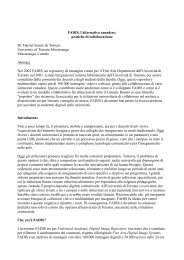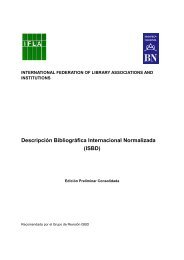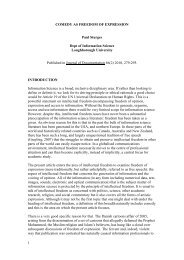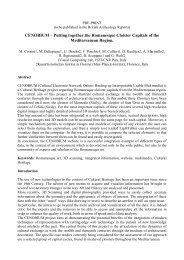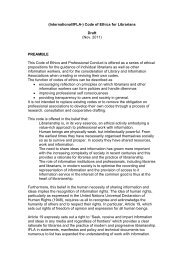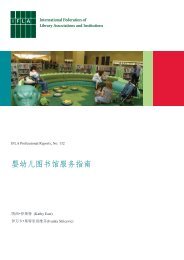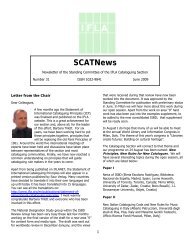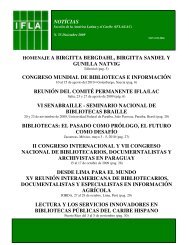ISBD(NBM) - IFLA
ISBD(NBM) - IFLA
ISBD(NBM) - IFLA
Create successful ePaper yourself
Turn your PDF publications into a flip-book with our unique Google optimized e-Paper software.
description), will need to be amended as appropriate to handle properly newly developing forms of<br />
material.<br />
0.1.2 Purpose<br />
The primary purpose of the <strong>ISBD</strong>s is to provide the stipulations for compatible descriptive<br />
cataloguing worldwide in order to aid the international exchange of bibliographic records between<br />
national bibliographic agencies and throughout the international library and information community.<br />
By specifying the elements which comprise a bibliographic description and by prescribing the order<br />
in which those elements should be presented and the punctuation by which they should be<br />
demarcated, the <strong>ISBD</strong>s aim to (A) make records from different sources interchangeable, so that<br />
records produced in one country can be easily accepted in library catalogues or other bibliographic<br />
lists in any other country; (B) assist in the interpretation of records across language barriers, so that<br />
records produced for users of one language can be interpreted by users of other languages; and (C)<br />
assist in the conversion of bibliographic records to machine-readable form.<br />
0.1.3 Use<br />
The <strong>ISBD</strong>s provide stipulations to cover the maximum amount of descriptive information required in<br />
a range of different bibliographic activities, and therefore include elements which are essential to one<br />
or more of those activities but not necessarily to all.<br />
It is recommended that the national bibliographic agency in each country, in accepting the<br />
responsibility of creating the definitive record for each publication issued in that country, prepare the<br />
definitive description containing all the mandatory elements set out in the relevant <strong>ISBD</strong> insofar as<br />
the information is applicable to the item being described. Certain elements are designated as<br />
optional and information on these elements can be included or omitted at the discretion of the<br />
agency.<br />
Other cataloguing organizations have a wider choice as they are not providing the definitive record<br />
for international exchange. They can select <strong>ISBD</strong> elements, mandatory or optional, for inclusion in<br />
their own records, provided that the elements selected are given in the prescribed order and<br />
transcribed with the prescribed punctuation according to the relevant <strong>ISBD</strong>.<br />
The <strong>ISBD</strong> description forms a part of a complete bibliographic record and is not normally used by<br />
itself. The other elements which make up a complete bibliographic record, such as headings, subject<br />
information, uniform titles, filing devices and tracings, are not included in the <strong>ISBD</strong> stipulations. The<br />
rules for such elements are normally given in cataloguing codes.<br />
0.2 Definitions<br />
Definitions are given for those terms used in the <strong>ISBD</strong>(<strong>NBM</strong>) in a special sense, or in one of several<br />
senses in general use. Some terms used in the normal bibliographic sense are also defined. Terms<br />
for categories of materials are defined in Appendix C.<br />
Accompanying material<br />
Accompanying material<br />
statement<br />
Any material accompanying the main part(s) of the item being<br />
described, and intended to be used with it.<br />
A brief description of accompanying material.<br />
2



